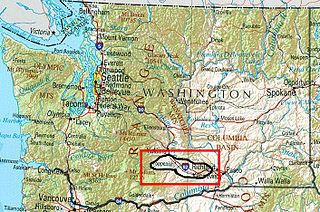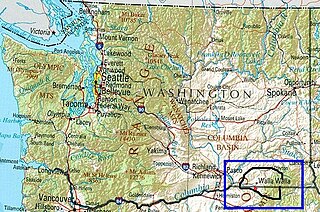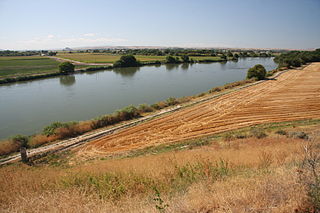
An American Viticultural Area (AVA) is a designated wine grape-growing region in the United States, providing an official appellation for the mutual benefit of wineries and consumers. Winemakers frequently want their consumers to know about the geographic pedigree of their wines, as wines from a particular area can possess distinctive characteristics. Consumers often seek out wines from specific AVAs, and certain wines of particular pedigrees can claim premium prices and loyal customers. If a wine is labeled with an AVA, at least 85% of the grapes that make up the wine must have been grown in the AVA, and the wine must be fully finished within the state where the AVA is located.

Washington wine is a wine produced from grape varieties grown in the U.S. state of Washington. Washington ranks second in the United States in the production of wine. By 2017, the state had over 55,000 acres (220 km2) of vineyards, a harvest of 229,000 short tons (208,000 t) of grapes, and exports going to over 40 countries around the world from the 940+ wineries located in the state. While there are some viticultural activities in the cooler, wetter western half of the state, the majority (99.9%) of wine grape production takes place in the shrub-steppe eastern half. The rain shadow of the Cascade Range leaves the Columbia River Basin with around 8 inches (200 mm) of annual rain fall, making irrigation and water rights of paramount interest to the Washington wine industry. Viticulture in the state is also influenced by long sunlight hours and consistent temperatures.
The state of Oregon in the United States has established an international reputation for its production of wine, ranking fourth in the country behind California, Washington, and New York. Oregon has several different growing regions within the state's borders that are well-suited to the cultivation of grapes; additional regions straddle the border between Oregon and the states of Washington and Idaho. Wine making dates back to pioneer times in the 1840s, with commercial production beginning in the 1960s.

Willamette Valley is an American Viticultural Area (AVA) which lies in the Willamette Valley of Oregon. The AVA is the wine growing region which encompasses the drainage basin of the Willamette River. It stretches from the Columbia River in the north to just south of Eugene in the south, where the Willamette Valley ends; and from the Oregon Coast Range in the west to the Cascade Mountains in the east. At 5,360 square miles, it is the largest AVA in the state, and contains most of the state's wineries; approximately 908 as of 2021.

The Dundee Hills AVA is an American Viticultural Area located in Yamhill County, Oregon. It is entirely contained within the Willamette Valley AVA, and is approximately 28 miles (45 km) southwest of Portland, near the towns of Dundee and Dayton. The area is 6,940 acres (2,809 ha) in total size, with 1,300 acres (526 ha) planted with grapes. The Dundee Hills are a north-south oriented line of hills on the western side of the Willamette River valley. The soil is red in color, rich in iron, relatively infertile, making it suitable for grape cultivation. The region gets 30 inches (76 cm) to 45 inches (114 cm) of rainfall per year. The Chehalem Mountains to the north protect the region from the cool breezes that enter Willamette Valley from the Columbia Gorge. Over 25 wineries and independent vineyards in this region produce over 44,000 cases of wine.

Columbia Valley is an American Viticultural Area (AVA) which lies within the Columbia River Plateau, through much of central and southern Washington state, with a section crossing the state boundary into northern Oregon south of the Columbia River. The viticultural area includes the drainage basin of the Columbia River and its tributaries through much of Washington. It was established by the Bureau of Alcohol, Tobacco and Firearms (ATF), Treasury on December 13, 1984 after evaluating the petition filed by Drs, Walter Clore and Wade Wolfe of Prosser, Washington on behalf of Washington’s oldest and largest winery, Chateau Ste. Michelle, and by William Blosser of the Sokol Blosser Winery, Dundee, Oregon. Allen Shoup, president of Chateau Ste. Michelle, understood the importance of obtaining appellation status to grow the reputation of the Northwest viticulture industry.

Yakima Valley is the first American Viticultural Area (AVA) established within Washington state, gaining the recognition on May 4, 1983. Within the vast Columbia Valley AVA, Yakima Valley appellation cultivates more than 53,000 acres (21,448 ha) giving the region the largest concentration of wineries and vineyards in the state. The most widely planted varietals in the area are Chardonnay, Riesling, Merlot, Cabernet Sauvignon, Pinot gris, and Syrah. Nearly 40% of Washington's annual wine production is made from Yakima Valley grapes. In addition to grapes, the Yakima Valley is also home to several fruit orchards growing apples, cherries, nectarines, peaches, pears and plums. Around the town of Zillah, there is the Zillah Fruit Loop driving tour through the area's orchards and vineyards. The area is also home to nearly 80% of the US hop production.

Walla Walla Valley is an American Viticultural Area (AVA) located within Washington state and extending partly into the northeastern corner of Oregon. The wine region is entirely included within the larger Columbia Valley AVA. In addition to grapes, the area produces sweet onions, wheat and strawberries After the Yakima Valley AVA, the Walla Walla AVA has the second highest concentration of vineyards and wineries in Washington State. Walla Walla hosts about 140 wineries. The area was recognized on March 7, 1984 by the Bureau of Alcohol, Tobacco and Firearms (ATF), Treasury after reviewing the petition submitted by Mr. Richard L Small, President of the Walla Walla Valley Winegrowers Association, for the establishment of a viticultural area in southeast Washington and northeast Oregon, east of Lake Wallula, to be known as "Walls Walls Valley." At the time, Walla Walla Valley viticultural area was approximately 178,560 acres (279 sq mi) with two bonded wineries and about 60 acres (24 ha) from several vineyards.

Horse Heaven Hills is an American Viticultural Area (AVA) in southeastern Washington lying in portions of Klickitat, Yakima, and Benton counties, north and west of the Columbia River and south of the Yakima Valley and lies within the vast Columbia Valley appellation. Horse Heaven Hills was established by the Alcohol and Tobacco Tax and Trade Bureau {TTB), Treasury on June 30, 2005 after reviewing the petition filed by Paul D. Lucas on behalf of regional wine grape growers. Horse Heaven Hills viticultural area is about 60 miles (97 km) long and 22 miles (35 km) wide located 115 miles (185 km) east from Vancouver, Washington. The appellation encompasses 570,000 acres (891 sq mi) with about 6,400 acres (2,590 ha) under vine.

Santa Maria Valley is an American Viticultural Area (AVA) which straddles the boundary of Santa Barbara and San Luis Obispo counties in California's multi-county Central Coast AVA. It was established on August 5, 1981, by the Bureau of Alcohol, Tobacco, Firearms and Explosives (ATF) as California's second oldest AVA. A portion of the AVA crosses the Cuyama River into the southernmost corner of San Luis Obispo County. The east–west orientation of the 152.3 square miles with a wide, open valley and rolling hills means cool winds and fog flow in freely from the Pacific Ocean, settling most noticeably in lower-lying areas. The result is a mild Mediterranean climate that lengthens the growing season and contributes to the eventual sugar/acid balance in the grapes from Santa Maria Valley's 7,500 acres (3,000 ha) cultivated vineyards. On January 28, 2011, the AVA was granted an 29.4 square miles expansion to its southern boundary.
Snipes Mountain is an American Viticultural Area (AVA) located in the Yakima Valley of Washington state. It was established by the Alcohol and Tobacco Tax and Trade Bureau {TTB), Treasury on January 21, 2009 as the state's 10th AVA. It is the second smallest AVA in the state, after the Red Mountain AVA, and has one of the state's longest viticultural histories. The 4,145 acres (6 sq mi) appellation is a sub-AVA of the Yakima Valley AVA and the Columbia Valley AVA. It is located above and between the towns of Sunnyside and Granger around Outlook, Washington, in the southeast corner of the Yakima Valley.

Lake Chelan is an American Viticultural Area (AVA) in Washington state. The appellation lies about 112 miles (180 km) northeast of Seattle located in north-central Washington's Lake Chelan Valley and is a sub-appellation of the vast Columbia Valley AVA. It lies east of the Puget Sound viticultural area and north or west of the other Washington State viticultural areas. It borders the Columbia Valley viticultural area on is eastern side and does not include any portion of other Washington viticultural areas except the Columbia Valley AVA.

Naches Heights is an American Viticultural Area (AVA) in Yakima County, Washington. The AVA was recognized officially by the Alcohol and Tobacco Tax and Trade Bureau {TTB), Treasury on January 13, 2012 after reviewing the petition submitted by R. Paul Beveridge, owner of Wilridge Winery and Vineyard, to establish the viticultural area named "Naches Heights." The AVA is located entirely within the vast Columbia Valley AVA with the city of Yakima to the southeast in a valley at a lower elevation. The Naches Heights appellation encompasses 13,254 acres (21 sq mi) and contains 105 acres (42 ha) of commercial vineyards either producing or expecting to produce wine grapes in the foreseeable future. Additionally, it is the first AVA in Washington state to be fully sustainable, with all 7 vineyards practicing in either biodynamic or LIVE certification. At the recognition date, only 37.2 acres (15 ha) were under vine, making the AVA the smallest planted wine region in Washington.

The Rocks District of Milton-Freewater is an American Viticultural Area (AVA) in Umatilla County, Oregon that is a sub-appellation of the Walla Walla Valley AVA, and both lie within the vast Columbia Valley AVA. The appellation was established on March 11, 2015 by the Alcohol and Tobacco Tax and Trade Bureau (TTB), Treasury after reviewing the petition submitted from Dr. Kevin R. Pogue, a professor of geology at Whitman College in Walla Walla, Washington, proposing the viticultural area called "The Rocks District of Milton-Freewater."

Ancient Lakes of Columbia Valley, also locally called "Ancient Lakes", is an American Viticultural Area {AVA) which lies on the western edge of the Columbia Basin near the town of Quincy in Douglas, Grant, and Kittitas Counties in the state of Washington. The appellation lies entirely within the vast Columbia Valley viticultural area and was established on November 19, 2012, as the state's 13th AVA, by the Alcohol and Tobacco Tax and Trade Bureau {TTB), Treasury. The petition was received by TTB from Joan R. Davenport, a professor of soil sciences at Washington State University, and Cameron Fries of White Heron Cellars, on behalf of the vintners and grape growers in the Ancient Lakes region in central Washington, proposing the establishment of the "Ancient Lakes of Columbia Valley" viticultural area.

Eagle Foothills is the second American Viticultural Area (AVA) in the state of Idaho located in the southwestern region in Gem and Ada Counties. The area lies southeast of Emmett, north of Eagle and approximately 10 miles (16 km) northwest of the city of Boise. It was established on December 28, 2015 by the Alcohol and Tobacco Tax and Trade Bureau (TTB), Treasury as the first sub-appellation in the vast Snake River Valley viticultural area and the first appellation entirely within Idaho’s state borders. It does not overlap with any existing or proposed AVA. Eagle Foothills lies at the north bank of Ancient Lake Idaho with its elevations ranging from 2,490 to 3,412 feet (759–1,040 m). The area encompasses 49,815 acres (78 sq mi) with nearly 70 acres (28 ha) under vine with plans to add 472 acres (191 ha) and seven vineyards. Its USDA plant hardiness zones are 7a and 7b. Vineyard elevations are below 3,000 feet (914 m). The majority of viticulture activity is at 3 Horse Ranch Vineyards with its 46 acres (19 ha) in center of the appellation. The cool climate and relatively short growing season are suitable for growing early to mid-season varietals such as Chardonnay, Pinot Gris and Riesling.
Lewis-Clark Valley is Idaho's third American Viticultural Areas (AVA) officially established by the Alcohol and Tobacco Tax and Trade Bureau (TTB), Treasury on May 20, 2016. It borders the northern part of the established Columbia Valley AVA. The region encompasses 479 square miles with nearly 100 acres (40 ha) under vine throughout the Lewis-Clark Valley between the Clearwater and mid-Snake Rivers and their tributaries. About 72%, 219,838 acres (343.497 sq mi), is located in Idaho with the rest in Washington. The topography consists primarily of deep, V-notched canyons, low plateaus, and bench lands formed by the two rivers. There were 3 wineries within the appellation, as well as 16 commercially-producing vineyards with elevations approximately below 2,000 feet (610 m). Lewis-Clark Valley boundaries forced the realignment of the existing Columbia Valley viticultural area by expanding into its area based on topography, climate and soil conditions. The realignment more accurately separated the terroir differences between the two appellations. Roughly about 72% of Lewis-Clark Valley is located in Idaho and the rest in Washington.
Lower Long Tom is an American Viticultural Area (AVA) located in Oregon's southern Willamette Valley in Lane and Benton Counties, near the towns of Junction City and Monroe. The district was established on December 10, 2021, by the Alcohol and Tobacco Tax and Trade Bureau. Its coverage is approximately 25,000 acres (10,117 ha) and contains 12 wineries and 24 commercially-producing vineyards that plant approximately 575 acres (233 ha). It lies entirely within the Willamette Valley AVA. The region is primarily known for its Pinot noir and Pinot gris.

Santa Barbara County wine is an appellation that designates wine made from grapes grown mostly in Santa Barbara County, California which is located approximately 50 miles (80 km) north of Los Angeles County. County names in the United States automatically qualify as legal appellations of origin for wine produced from grapes grown in that county and do not require registration with the Alcohol and Tobacco Tax and Trade Bureau (TTB) of the Treasury Department. TTB was created in January 2003, when the Bureau of Alcohol, Tobacco and Firearms, or ATF, was extensively reorganized under the provisions of the Homeland Security Act of 2002.

The Burn of Columbia Valley is an American Viticultural Area (AVA) located within Klickitat County in south-central Washington on the north banks of the Columbia River along the Oregon state border. The Burn of Columbia Valley was established by the Alcohol and Tobacco Tax and Trade Bureau {TTB), Treasury on July 17, 2021, after reviewing a petition received from Kevin Corliss, Vice President of Vineyards for Ste. Michelle Wine Estates, Joan R. Davenport, Professor of Soil Sciences at Washington State University, and John Derrick, Vice President of Operations for Mercer Ranches, Inc., proposing “The Burn of Columbia Valley” viticultural area. The appellation, known colloquially as “The Burn,” encompasses about 16,870 acres (26 sq mi) where 3 commercial vineyards cultivate approximately 1,261 acres (510 ha) as many Washington wineries source grapes from here. The state's 18th AVA lies entirely within the vast Columbia Valley appellation and stands alone between the Columbia Gorge and the Horse Heaven Hills viticultural areas. The distinguishing features of The Burn of Columbia Valley are its soils, climate, and topography.

















